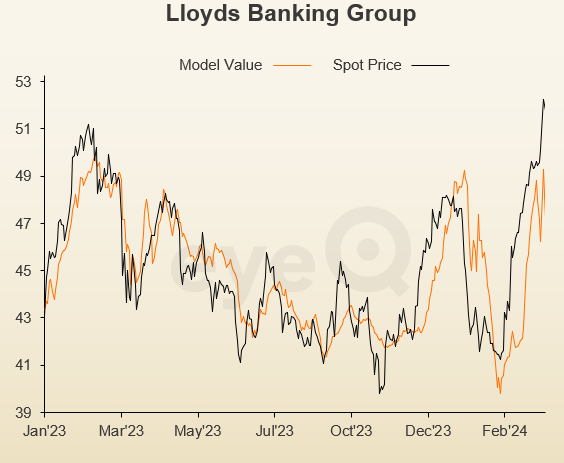eyeQ: have Lloyds Bank shares got overexcited?
interactive investor has teamed up with the experts at eyeQ who use artificial intelligence and their own smart machine to analyse macro conditions and generate actionable trading signals. This time, they study a popular high street lender.
26th March 2024 11:08
by Amit Khanna from eyeQ

"Our signals are crafted through macro-valuation, trend analysis, and meticulous back-testing. This combination ensures a comprehensive evaluation of an asset's value, market conditions, and historical performance." eyeQ
- Discover: eyeQ analysis explained | eyeQ: our smart machine in action | Glossary
Lloyds Banking Group
Trading signal:strategic short-term model
Model value: 47.2p
Fair Value Gap: +9.5% premium to model value
Model relevance: 76%
Data correct as at 26 March 2024. Please click glossary for explanation of terms.
Lloyds Banking Group (LSE:LLOY) is significantly geared to the UK economy through its exposure to mortgages, unsecured lending and commercial real estate. Indeed, it is the biggest mortgage lender in the UK with an almost 20% share. In other words, it is seen as a good barometer of UK economic health.
In the aftermath of last week’s Bank of England meeting, Lloyds was one of the biggest winners. This reflected confidence that interest rate cuts are firmly on the horizon, inflation will continue to fall, and in turn this will support rising economic activity. This is affirmed by the eyeQ machine. It shows the stock wants to see easier financial conditions i.e. falling government bond yields and inflation, alongside higher growth expectations.
Now, if the Bank of England is about to cut interest rates, that would ordinarily put pressure on the bank’s net interest income. Typically, there is a delay in passing on those rate cuts to borrowers. However, in the case of mortgages it is likely that competition between the banks remains high. This is especially in light of Nationwide’s planned acquisition of Virgin Money UK (LSE:VMUK). With the five-year UK government bond yield now sub-4%, it should ease the burden for those households set to refinance this year. However, this becomes a headwind for a mortgage-exposed bank such as Lloyds.
Just in the last six weeks, Lloyds shares have rallied over 25% and are now back above pre-Covid levels. On both eyeQ’s short-term and long-term models, the stock is about 10% rich to our model value. Macro explanatory power is 76% on the short-term model and only 44% on the long-term model. However, on both models these dislocations are particularly large relative to recent history.
eyeQ’s model value had been moving higher since February but has stalled over the last week. At this juncture, it is time for this economic bellwether to take a breather.

Source: eyeQ. Past performance is not a guide to future performance.
Useful terminology:
Model value
Where our smart machine calculates that any stock market index, singe stock or exchange-traded fund (ETF) should be priced (the fair value) given the overall macroeconomic environment.
Model (macro) relevance
How confident we are in the model value. The higher the number the better! Above 65% means the macro environment is critical, so any valuation signals carry strong weight. Below 65%, we deem that something other than macro is driving the price.
Fair Value Gap (FVG)
The difference between our model value (fair value) and where the price currently is. A positive Fair Value Gap means the security is above the model value, which we refer to as “rich”. A negative FVG means that it's cheap. The bigger the FVG, the bigger the dislocation and therefore a better entry level for trades.
Long Term model
This model looks at share prices over the last 12 months, captures the company’s relationship with growth, inflation, currency shifts, central bank policy etc and calculates our key results - model value, model relevance, Fair Value Gap.
These third-party research articles are provided by eyeQ (Quant Insight). interactive investor does not make any representation as to the completeness, accuracy or timeliness of the information provided, nor do we accept any liability for any losses, costs, liabilities or expenses that may arise directly or indirectly from your use of, or reliance on, the information (except where we have acted negligently, fraudulently or in wilful default in relation to the production or distribution of the information).
The value of your investments may go down as well as up. You may not get back all the money that you invest.
Equity research is provided for information purposes only. Neither eyeQ (Quant Insight) nor interactive investor have considered your personal circumstances, and the information provided should not be considered a personal recommendation. If you are in any doubt as to the action you should take, please consult an authorised financial adviser.
Disclosure
We use a combination of fundamental and technical analysis in forming our view as to the valuation and prospects of an investment. Where relevant we have set out those particular matters we think are important in the above article, but further detail can be found here.
Please note that our article on this investment should not be considered to be a regular publication.
Details of all recommendations issued by ii during the previous 12-month period can be found here.
ii adheres to a strict code of conduct. Contributors may hold shares or have other interests in companies included in these portfolios, which could create a conflict of interests. Contributors intending to write about any financial instruments in which they have an interest are required to disclose such interest to ii and in the article itself. ii will at all times consider whether such interest impairs the objectivity of the recommendation.
In addition, individuals involved in the production of investment articles are subject to a personal account dealing restriction, which prevents them from placing a transaction in the specified instrument(s) for a period before and for five working days after such publication. This is to avoid personal interests conflicting with the interests of the recipients of those investment articles.